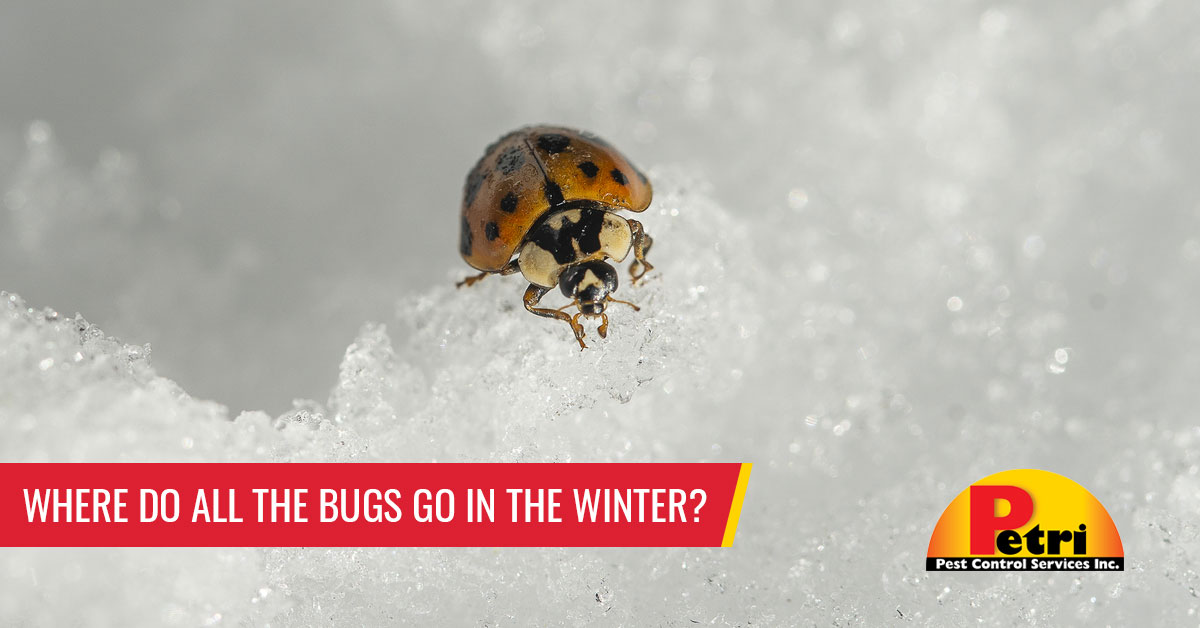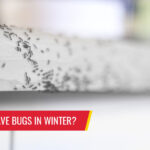
As fall turns into winter, days grow shorter, temperatures drop, and there don’t seem to be as many pests bothering people and causing trouble in homes, as well as outdoors. Where do bugs go in the winter? In most US states with colder temperatures during the winter, bugs have adapted ways to survive the colder temperatures. At temperatures below 45 degrees, most insects become inactive.
In South Florida, with average temperatures ranging in the 60s and 70s, bugs can stay active year-round, although insects are less active when the weather dips below 60 degrees. For other places where bugs seem to disappear, many are overwintering in several states of diapause, or hibernation – this is how they wait out the winter. While diapause is a physiological dormancy, occurring in any stage of an insect’s development, hibernation is inactive winter sleep. Insects stand a better chance of surviving winter when temperatures are fairly stable, with not many thaws and freezes. Insects can be tricked by weather that seems like spring, only to be followed by a drastic change in temperatures. Some bugs do die off during cooler times, while some migrate to warmer climates. Some bugs convert the water in their bodies to glycerol, which acts like antifreeze, keeping insects insulated from the freezing temperatures.
Here are some different ways bugs overwinter.
- Butterflies
Monarch butterflies migrate to Mexico and southern California in the fall and winter months but Monarch migrations can start as early as the summer in areas further north. During the cooler months and shorter days, with poor host plant quality, some adult Monarchs emerge in reproductive diapause to prepare for their imminent southern migration. Monarchs leave their southern destinations for points north to lay their eggs in the spring. - Mosquitoes
Male mosquitoes die at the end of the season. Only females overwinter, substituting blood meals needed to nurture eggs into fat-building meals to adapt to the cooler temperatures. Some mosquitoes spend the winter suspended in larvae or pupa stages until the days get longer and temperatures start to warm. However, with climate change, temperatures can stay warmer in South Florida, allowing mosquitoes to stay active all year long. - Honey Bees
During the winter, honey bees remain semi-active, wintering in hollow trees generating body heat by the oxidation of nearly 30 pounds of stored honey into body heat produced by worker bees’ wing-fanning heat throughout the hive. - Yellowjackets, wasps, and hornets
With predator bees, only newly fertilized queens survive the winter. While the other members of these colonies die off at the end of the season, queens hibernate during the winter under debris, inside attics and wall voids, or in other sheltered spaces, such as tree stumps. The first warm days of spring bring the queens out in search of new nest locations.
Insects find micro-habitats for hibernation
Like these bee queens, many insects find shelter and nourishment during the winter in micro-habitats under the soil, inside the wood in trees and logs, and some even in the abnormal growths that occur on leaves, twigs, roots, or flowers of many plants, called “galls.” Temperatures are only a part of the picture that causes insect inactivity.
Snow
While snow makes everything beautiful and covers all manner of eyesores in our environment, blankets of snow insulate the ground and regulate ground temperature. Shorter days also signal insects that winter is on its way.
- Ants
Eating large amounts of food in the fall prepares ants for winter’s hibernation. As temperatures drop, ants experience a slow down that makes them sluggish and ready to spend the winter under the soil, in tree bark, under rocks, or indoors where it’s warm. Ant activity resumes in the spring when temperatures start to rise. - Flies
The most common filth and nuisance flies that bother us in the spring and summer spend the winter in either the larval or pupal stage. Favorite hibernation sites include under manure piles and other organic matter or in other protected locations. Some flies, such as cluster flies, find their way into homes in large numbers and “cluster” in walls, attics, and basements in homes, as well as in the corners of a room and near windows. - Cockroaches
Because most cockroach species can’t survive temperatures less than 15 degrees Fahrenheit, these annoying pests tend to move indoors in basements, crawlspaces, and other dark spaces for the warmth these spaces provide. Like other insects, lower temperatures cause development rates in cockroaches to slow down, reproducing at slower rates, so you may not see as many in your home in the cooler months. Some adults and immature roaches spend the winter in a diapause state. - Spiders
You might not see as many cobwebs in your home in the cooler months due in part to the reduction of other insects that spiders prey on during the fall and winter. Decreased spider activity is also partially due to the cooler temperatures and shorter days. Black widows often overwinter as adults inside buildings or in outdoor shelters such as utility sheds and crawlspaces. The better news is that brown recluse spiders become inactive at less than 44 degrees Fahrenheit.
Proactive homeowners
In most parts of the country, the sooner warm weather starts, the more insect activity will occur during the warmer seasons. In South Florida, insects can remain active all year long but insect activity is still reduced due to shorter days. During the cooler months in South Florida, proactive homeowners can prepare for the warmer months by working with a trusted pest professional, such as Petri Pest Control Services to head off insect activity before the spring and summer months. Specializing in treating the perimeter of your property, our technicians strategically place baits on the exterior of your home that act to pest-proof your home and maintain your safe space year-round.
Petri Pest Control Services, a local, family-owned and operated company, provides your South Florida home with a pest-free environment year-round. From our office in Pompano Beach, Petri Pest Control Services wants to be your neighborhood pest control service that you can always rely on for fast, affordable pest control solutions. Let’s schedule your free pest inspection!


